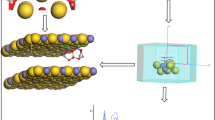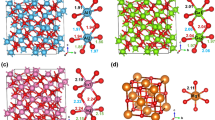Abstract
Using molecular mechanics (MM+), semi-empirical (PM6) and density functional theory (DFT) (B3LYP) methods we characterized bismuth nanotubes. In addition, we predicted the bismuth clusters {Bi20(C 5V ), Bi24(C 6v ), Bi28(C 1 ), B32(D 3H ), Bi60(C I )} and calculated their conductor properties.

One of possible hydrogen-containing bismuth fullerene-like nanostructures





Similar content being viewed by others
References
Norman NC (ed) (1997) Chemistry of arsenic, antimony and bismuth, 1st edn. Springer, Heidelberg, p 496
Cotton FA, Wilkinson G, Murillo CA, Bochmann M (1999) Advanced inorganic chemistry, 6th edn. Wiley, Hoboken, p 1376
Sergeev GB (2006) Nanochemistry, 1st edn. Elsevier, Amsterdam, p 262
Koch C, Ovid'ko I, Seal S, Veprek S (2007) Structural nanocrystalline materials: fundamentals and applications, 1st edn. Cambridge University Press, p 364
Fryxell GE, Cao G (2007) Environmental applications of nanomaterials: synthesis, sorbents and sensors. Imperial College Press, p 520
Asthana R, Kumar A, Dahotre NB (2005) Materials processing and manufacturing science, 1st edn. Butterworth-Heinemann, Oxford, p 656
Sakka S (2004) Handbook of sol–gel science and technology: processing characterization and applications, 1 edn. Springer, Heidelberg, p 1980
Soderberg BCG (2003) Transition metals in organic synthesis: highlights for the year 2000. Coord Chem Rev 241(1):147–247
Cao G, Liu D (2008) Template-based synthesis of nanorod, nanowire, and nanotube arrays. Adv Colloid Interface Sci 136(1):45–64
Dresselhaus MS, Lin YM, Rabin O, Jorio A, Souza Filho AG, Pimenta MA et al. (2003) Nanowires and nanotubes. Mater Sci Eng C 23(1):129–140
Penner RM, Zach MP, Favier F (2007) Methods for fabricating metal nanowires. United States Patent 7220346. http://www.freepatentsonline.com/7220346.html
Guo T (2006) Nanoparticle radiosensitizers. Patent WO2006037081
Zhou G, Li L, Li GH (2010) Enhancement of thermoelectric figure of merit in bismuth nanotubes. Appl Phys Lett 97(2):023112/1–0233112/3
Ma D, Zhao J, Li Y, Su X, Hou S, Zhao Y, Hao X-L, Li L (2010) Organic molecule directed synthesis of bismuth nanostructures with varied shapes in aqueous solution and their optical characterization. Colloids Surf A 368(1–3):105–111
Derrouiche S, Zoican LC, Wang C, Pfefferle L (2010) Energy-induced morphology changes in bismuth nanotubes. J Phys Chem C 114(10):4336–4339
Tao X, Qu J, Sun L, Zhao Y (2009) Rapid synthesis and characterization of bismuth nanotubes. Huahue Yanjiu 20(3):74–76
Yang D, Meng G, Xu Q, Han F, Kong M, Zhang L (2008) Electronic transport behavior of bismuth nanotubes with a predesigned wall thickness. J Phys Chem C 112(23):8614–8616
Derouiche S, Loebrick CZ, Pfefferle L (2010) Optimization of routes for the synthesis of bismuth nanotubes: implications for nanostructure form and selectivity. J Phys Chem C 114(8):3431–3440
Su C, Liu H-T, Li J-M (2002) Bismuth nanotubes: potential semiconducting materials. Nanotechnology 13(6):746–749
Rasche B, Seifert G, Enyashin A (2010) Stability and electronic properties of bismuth nanotubes. J Phys Chem C 114:22092–22097
Li SF, Gao L, Gong XG, Guo ZX (2008) No cage, no tube: relative stabilities of nanostructures. J Phys Chem C 112(34):13200–13203
Qi J, Shi D, Jiang X (2008) The structures and electronic properties of double-wall bismuth nanotubes from first-principle calculations. Chem Phys Lett 460(1–3):266–271
C-r Su, Li J-M (2002) First principles study on electronic property of bismuth nanotubes. Yuanzihe Wuli Pinglun 19(2):224–226
Boldt R, Kaiser M, Kohler D, Krumeich F, Ruck M (2010) High-yield synthesis and structure of double-walled bismuth nanotubes. Nano Lett 10:208–210
Gao L, Li P, Lu H, Li SF, Guo ZX (2008) Size- and charge-dependent geometric and electronic structures of Bin (Bin-) clusters (n = 2–13) by first-principles. simulations. J Chem Phys 128(19):194304/1–194304/9
Karttunen AJ, Linnolahti M, Pakkanen TA (2011) Structural and electronic trends among group 15 polyhedral fullerenes. Theor Chem Acc 129:413–422
http://www.hyper.com/ Accessed on 9 Feb 2012
http://www.gaussian.com/g_prod/g09.htm Accessed on 9 Feb 2012
http://www.chemcraftprog.com/ Accessed on 9 Feb 2012
http://www.ks.uiuc.edu/Research/vmd/ Accessed on 9 Feb 2012
Mina Yoon SY, Wang E, Zhang Z (2007) Charged fullerenes as high-capacity hydrogen storage media. Nano Lett 7(9):2578–2583
Author information
Authors and Affiliations
Corresponding author
Rights and permissions
About this article
Cite this article
Kharissova, O.V., Osorio, M., Vázquez, M.S. et al. Computational chemistry calculations of stability for bismuth nanotubes, fullerene-like structures and hydrogen-containing nanostructures. J Mol Model 18, 3981–3992 (2012). https://doi.org/10.1007/s00894-012-1401-8
Received:
Accepted:
Published:
Issue Date:
DOI: https://doi.org/10.1007/s00894-012-1401-8




